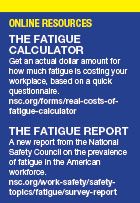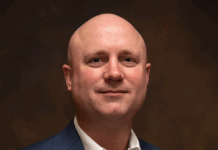Blame it on Thomas Edison. His invention of the light bulb some 140 years ago led to a monumental shift in cultural norms, and average sleep times declined from nine to seven hours or less.
In all fairness, his invention can’t shoulder all the blame for the fatigue epidemic that’s sweeping the U.S. Expanding waist lines have led to the growing prevalence of sleep apnea, leaving many dazed and confused. Twenty-two million Americans suffer from the problem, and more than 80% of sufferers are undiagnosed, according to data from the American Sleep Apnea Association.
Apart from a long list of health-related consequences, lack of sleep can have more far-reaching, catastrophic ramifications for the industrial and transportation sectors. Anyone who operates machinery or watches a process console is a threat to safety when fatigued.
A National Safety Council study found that injury risk begins increasing beyond an 8-hour shift, with a 13% increase in the 10th hour and a 30% increase in the 12th hour. In a recent study released by AAA, researchers determined that 9.5% of all crashes and 10.8% of crashes resulting in significant property damage involved drowsiness.
Fortunately, some leaders in manufacturing and industry are beginning to shine a light on the problem and for the first time are taking steps to incorporate fatigue risk management guidelines into their work practices. Emily Whitcomb, a fatigue expert, began spearheading a fatigue initiative at the National Safety Council in 2016. The NSC is developing educational materials and other resources regarding fatigue this summer, and the council plans to hold its first-ever Fatigue Conference in Seattle in 2019.
“We have lot of work to do with raising awareness to employers about this issue,” Whitcomb says. “There’s a mindset across the U.S. that sacrificing sleep for other responsibilities is a badge of honor, and that it makes you look tougher or stronger somehow. We’re trying to highlight that fatigue can be a hazard in the workplace, and we want to work with employers to adjust any workplace practices that are adding to fatigue or not helping employees get the sleep or rest that they need.”
For the past 18 months, the NSC has focused on building partnerships with employers, and in December 2016 it hosted a fatigue “blue ribbon panel” attended by 60 experts on fatigue, sleep science and safety. “We had about five strategic breakout groups, where everyone would discuss the field of fatigue and sleep health, where it’s going, where it needs to go, what opportunities exist, what partnerships need to be built, etc.,” Whitcomb notes.
The South Louisiana Chapter of NSC in New Orleans, under the direction of president and CEO Beth Inbau, will play a role in regionalizing the process. “The Safety Council knows that the night shift is most vulnerable because it’s when your internal clock wants you to sleep, so therefore you are already at risk,” Inbau says. “Secondly, the night shift is usually the one that has the least amount of supervision, and people tend to take shortcuts and mistakes are made. The results could be catastrophic.” Fatigue should be of particular concern, she adds, because it affects short-term memory and a worker’s ability to learn new tasks.
Louisiana’s industrial community hasn’t been left out of the process. Under the direction of Occupational Health Manager Steven Lerman, ExxonMobil participated on the NSC panel and has taken a leadership role in implementing American Petroleum Institute fatigue risk management protocols.
Locally, Labor Relations Manager David Dartez has helped work out a customizable plan for ExxonMobil’s Baton Rouge complex that complies with API standards. About one-third of ExxonMobil Baton Rouge employees, he says, work in “safety-sensitive” positions.
“Safety-sensitive positions typically include those operations employees who work 12-hour rotating shifts,” Dartez says. “They’re responsible for opening and closing valves, for ensuring the equipment operates properly, and for taking action when things are abnormal. Those are the individuals who have to respond and take action to either correct the abnormal situation or potentially shut a unit down.”
As part of its risk management plan, ExxonMobil Baton Rouge requires a mandatory day off in a two-week period. Supervisors are also encouraged to have conversations with employees and to take action if fatigue is suspected, such as authorizing additional break time or a schedule change.
As another alternative, the NSC encourages the adoption of designated areas where employees can sleep or rest before leaving for home.
During her days working at PPG Industries, Kathy Trahan, president and CEO of the Alliance Safety Council in Baton Rouge, recalls the company sending fatigued employees home in a taxi. “If you worked a double shift, they sent you home in a taxi and picked you up after eight hours of sleep,” Trahan says.
“After that amount of work and that many hours, it’s hard to stay alert when you’re that tired,” she adds. “The sleep deficit buildup over consecutive nights or short periods of interrupted sleep can decline productivity, performance and reaction times, which can lead to safety issues and impair your ability to concentrate. Seventeen waking hours is the equivalent to a blood alcohol level of .05 and 21 hours is .08.”

SOLUTIONS & SYSTEMS
Irrespective of organizational tactics, one of the primary causes of fatigue—sleep apnea—requires a medical solution, says Michael Trufant, part owner of Launch Media in Baton Rouge and business unit manager at Aeroflow Healthcare in Asheville, North Carolina.
“It’s estimated that up to 30% of workers in the field probably have it,” Trufant says. “The danger with sleep apnea is that you’re turning off oxygen to your lungs, so you get heart disease, diabetes, hypertension, arrhythmias … a whole host of things.” This can lead to preventable medical costs—research performed for the trucking industry found that a driver with a chronic fatigue-related disease can accumulate an average of $6,000 in medical costs each year.
 For this and a host of other reasons, screening employees for sleep apnea is vitally important for the industrial owner or contractor. “For one thing, you prevent incidences, so you’re protecting your liability, risk and safety,” Trufant explains. “Secondly, you’re saving from a medical cost standpoint. And then you get a better employee. They’ll live 10 years longer, and they’ll go home to their family feeling better.”
For this and a host of other reasons, screening employees for sleep apnea is vitally important for the industrial owner or contractor. “For one thing, you prevent incidences, so you’re protecting your liability, risk and safety,” Trufant explains. “Secondly, you’re saving from a medical cost standpoint. And then you get a better employee. They’ll live 10 years longer, and they’ll go home to their family feeling better.”
While most workers initially resist the use of a CPAP (Continuous Positive Airway Pressure) device for their sleep apnea, many quickly notice an improvement in health and performance.
Mike Harnett, an internationally known fatigue expert and vice president—human factors at Six Safety Systems in Calgary, Alberta, helps companies incorporate fatigue into their management systems by developing “fit-for-duty” solutions.
“In most cases, organizations are realizing that fatigue is an issue, but they’ve never looked at it as a root cause or as a contributing factor,” she says. “If an employee fell asleep, it used to be a disciplinary issue. That person didn’t care about their job or they were lazy. There was a myth that an employee could stay awake if they tried hard enough, which goes completely against what we know from a physiological standpoint.”
A “systems approach” is most effective in tackling fatigue, thereby establishing tangible steps to address the problem. “It means we have to understand why did that human error occur? What was in our system that made them think that was a good decision? It could be the fact that there were policies and procedures that they didn’t follow, but the reason they didn’t follow them is because they’ve never been enforced.”
Harnett’s company follows a prescribed management system strategy template that can be applied to a variety of business processes. “With the fatigue risk management system, you look at the organizational culture, at strategic plans, policies and procedures, etc. For example, if someone walks in and says, ‘I’m tired,’ and you know they still have four hours on shift, what is your process for handling that?”
To assist in the creation of a fatigue-resistant work schedule, Harnett uses biomathematical modeling software, whereby a schedule’s physiological implications, circadian rhythms and overall design are examined. With biomathematical modeling, safety professionals can enter start and finish times, add break times, and include workload-type data. The modeling software then shows how much time is spent in risk-free or minimal risk conditions, how much is spent in moderate risk, and so on.
Additionally, a Needs Assessment Gap Analysis can evaluate an employer’s current methods for fatigue-mitigation. In the process, they identify fatigue-related hazards, examine the shift schedule and ask specific questions to be analyzed from a science-based perspective.
THE EDUCATION COMPONENT
Fatigue on the jobsite can lead to a loss of situational awareness, an underestimation of risk or poor productivity. That can mean flawed logic, slower information processing and more difficulty in complex decision making.
At ExxonMobil, education about the dangers of fatigue is a crucial part of the process. “We provide a fair amount of training for all employees to make sure they recognize their own potential for fatigue and how to address those issues,” Dartez says. “If someone is fatigued and they’re working on the job in one of these safety-sensitive positions, we always ask employees to talk to their supervisor.”
A supervisor can then authorize an appropriate break time or “in some extreme situations, we may pull the employee off shift and have someone come and relieve them.” Weekly safety meetings are also used as platforms to discuss fatigue-related topics, where employees raise concerns or issues.
The Alliance Safety Council in Baton Rouge addresses fatigue in its portfolio of training courses, specifically targeting the busing and trucking industries. According to the AAA Foundation for Traffic Safety, the percentage of crashes involving drowsiness is nearly eight times higher than federal estimates.
The recent research provides an unprecedented analysis of in-vehicle dashcam video from more than 700 crashes, confirming that the danger of drowsy driving soars above official estimates. In another study, the Centers for Disease Control and Prevention found that 35% of U.S. drivers sleep less than the recommended minimum of seven hours daily.
Trahan says this has direct implications for the petrochemical, oil and gas markets. “We’ve found that 60% of the time absenteeism from work was the result of an automobile incident or accident, whether it’s themselves or someone else in their family,” Trahan says.
The Alliance course tests response times and a person’s ability to recognize hazards while driving. “We provide a comprehensive library from which to create a customized risk mitigation for whatever the situation,” Trahan says. “There are so many initiatives around drowsy and distracted driving. It’s on everyone’s radar.”








